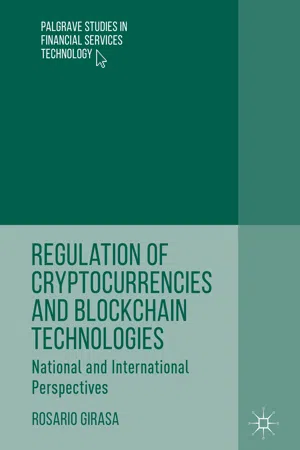
Regulation of Cryptocurrencies and Blockchain Technologies
National and International Perspectives
- English
- ePUB (mobile friendly)
- Available on iOS & Android
Regulation of Cryptocurrencies and Blockchain Technologies
National and International Perspectives
About this book
The book highlights the rise of Bitcoin, which is based on blockchain technology, and some of the many types of coins and tokens that emerged thereafter. Although Bitcoin and other cryptocurrencies have made national and international news with their dramatic rise and decline in value, nevertheless the underlying technology is being adopted by both industry and governments, which have noted the benefits of speed, cost efficiency, and protection from hacking. Based on numerous downloaded articles, laws, cases, and other materials, the book discusses the digital transformation, the types of cryptocurrencies, key actors, and the benefits and risks. It also addresses legal issues of digital technology and the evolving U.S. federal regulation. The varying treatment by individual U.S. states is reviewed together with attempts by organizations to arrive at a uniform regulatory regime. Both civil and criminal prosecutions are highlighted with an examination of the major cases that have arisen. Whether and how to tax cryptocurrency transactions both in the U.S. and internationally are analyzed, and ends with a speculative narrative of future developments.
Frequently asked questions
- Essential is ideal for learners and professionals who enjoy exploring a wide range of subjects. Access the Essential Library with 800,000+ trusted titles and best-sellers across business, personal growth, and the humanities. Includes unlimited reading time and Standard Read Aloud voice.
- Complete: Perfect for advanced learners and researchers needing full, unrestricted access. Unlock 1.4M+ books across hundreds of subjects, including academic and specialized titles. The Complete Plan also includes advanced features like Premium Read Aloud and Research Assistant.
Please note we cannot support devices running on iOS 13 and Android 7 or earlier. Learn more about using the app.
Information
International Regulation
Table of contents
- Cover
- Front Matter
- The Digital Transformation
- Technology Underlying Cryptocurrencies and Types of Cryptocurrencies
- Legal Issues of Digital Technology
- Federal Regulation of Virtual Currencies
- States’ Regulation of Virtual Currencies
- Criminal Prosecutions and Civil Litigation Concerning Virtual Currencies
- Crowdfunding and the Taxation of Virtual Currencies
- International Regulation
- Conclusion: The Future of Cryptocurrencies
- Back Matter